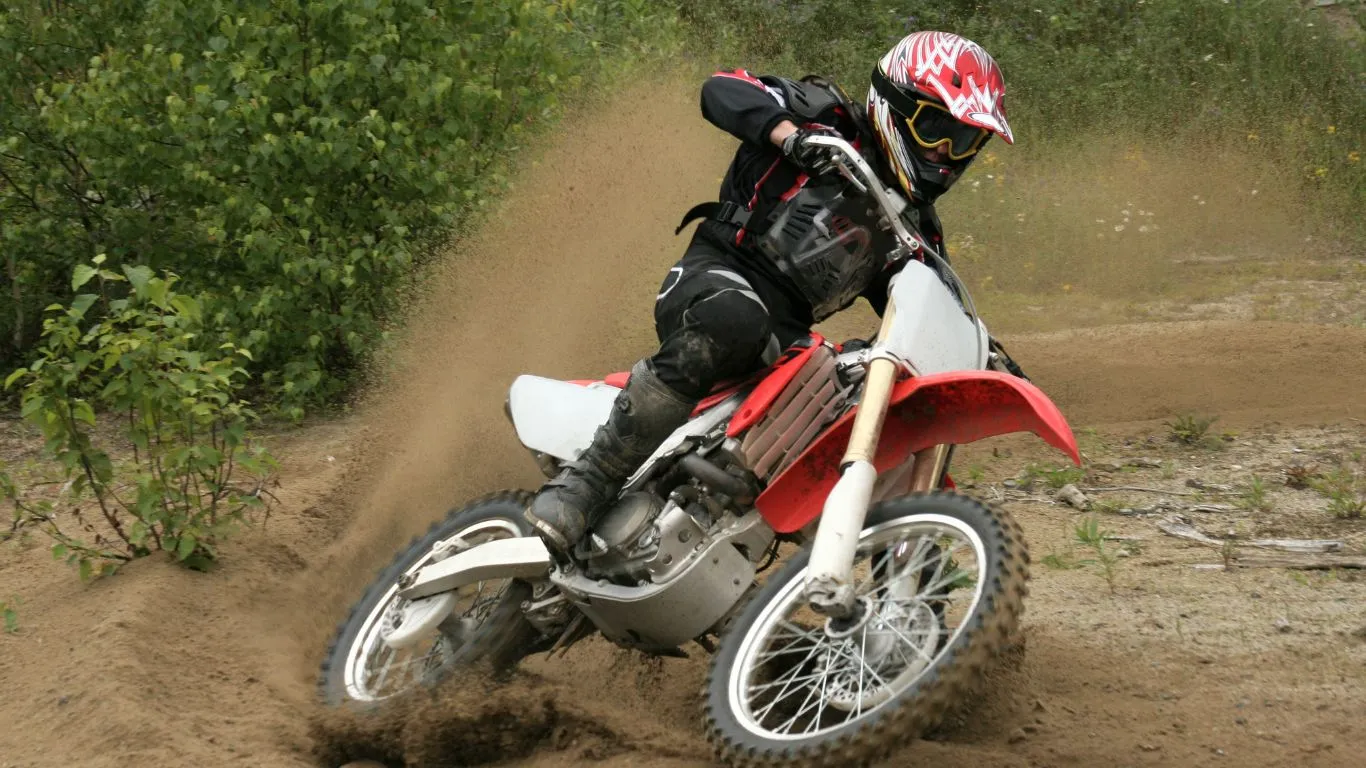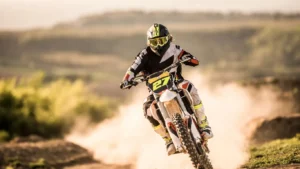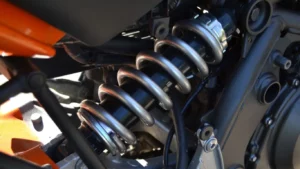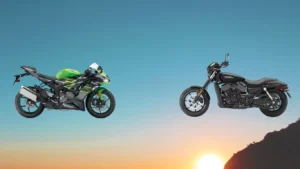Embarking on a journey through sandy terrains on your motorcycle can be both exhilarating and challenging. As the sand shifts beneath your motorcycle’s tires, the ride becomes a test of your riding skills and mastery of your machine. Riding a motorcycle in the sand is a unique experience that involves a combination of specific techniques and calculated movements.
This article is designed to guide you, the intrepid rider, on how to navigate through sandy terrains with ease and confidence. Whether you’re a seasoned rider seeking to improve your skills or a beginner venturing onto a sandy course for the first time, the tips and techniques outlined here will equip you for the task ahead!
Preparing Your Motorcycle for Sand Riding
Before venturing onto sandy terrain with your motorcycle, it’s critical to prep your bike for the unique challenges this environment brings. In the following sections, we’ll guide you through the necessary adjustments and techniques that transform your two-wheeler into a reliable sand companion.
Tire Selection and Pressure
Choosing the right tires for your sand adventure is crucial. The ideal tires for riding on sand are knobby off-road tires, which can provide the traction you’ll need on such a loose surface. Additionally, reducing your tire pressure will enhance grip and allow your motorcycle to navigate through sand, rather than fighting against it. A good starting point is to lower your tire pressure to about 12 to 15 psi, though this may vary based on your bike’s weight and the specific sand conditions.
Suspension Settings
Adjusting your bike’s suspension is another vital aspect of prepping for sand riding. The soft nature of the sand requires a stiffer suspension setup than typical road conditions. A stiffer suspension ensures better handling and a smoother ride over the shifting sand dunes. Experiment with different settings until you find what feels best, remembering that comfort and control are key.
Chain Tension
While riding in sand, your chain is more likely to gather grit, leading to potential wear and tear on the sprocket and other parts of your bike. Therefore, it’s important to have your chain slightly looser than usual to allow for this accumulation. Pay close attention to the chain throughout your ride, making sure it isn’t straining or showing signs of extreme wear.
Bike Weight Distribution
Proper weight distribution is essential when riding on sand. Aim to keep your weight more towards the back of the bike, helping the front tire to stay light and therefore making it easier to maneuver easily in the tough sandy conditions.
Choosing the Right Motorcycle for Sand Riding
The dance of motorcycling on a sandy terrain is an exciting adventure that demands both skill and an aptly equipped bike. From treading lightly over soft landscapes to holding your nerve on dune crests, the bike you choose significantly influences your sand riding experience.
The Need for a Sand-Appropriate
Motorcycle Choosing a motorcycle specifically tailored for sand riding is paramount. The structure, strength, agility, and versatility of the ride count when cruising on bumpy sand dunes. Unlike asphalt, sand is an inconsistent and shifting surface that requires a particularly robust motorcycle to navigate effectively.
Selecting a Motorcycle: Key Considerations
The type of sand, the weather, and your riding abilities all play a big role in deciding what kind of motorcycle to use for sand riding. Dual-sport bikes are often recommended for their off-road prowess, while big adventure bikes can handle more challenging terrains but might prove difficult for beginners. Lightness is critical too. A less heavy bike is easier to maneuver on sandy tracks.
Engine Capacity and Efficiency
The engine’s capacity and efficiency influence the horsepower, which, in turn, determines the bike’s power delivery and tractability on sand. Different engine configurations pose varying strengths and weaknesses in sand conditions. Single-cylinder engines tend to give better throttle control due to lower speeds and less wheel spin, therefore offering more grip, while twin-cylinder engines provide more sheer power and can blaze through deep sand effectively.
Mastering the Essential Riding Techniques for Sand
Unlocking the art of efficient sand riding is all about understanding and utilizing certain fundamental techniques. Whether it’s body positioning, throttle control, or how you shift your weight, mastering these skills can markedly increase your proficiency and satisfaction. Let’s delve further into these indispensable riding strategies.
Discovering the Right Throttle Control
Throttle control is an essential skill for sand riding. You need to maintain momentum in loose sand, but also find a balance to prevent spinning out. Too much throttle can cause your rear tire to spin excessively, wasting energy and causing you to lose control. On the other hand, insufficient throttle means you may end up bogged down.
Mastering the Art of Shifting Weight
In sand, optimal weight distribution far outweighs speed. As sand can shift beneath the tires, it’s vital to adapt constantly by shifting your weight. Typically, in straight lines, you’ll want to sit and lean back to maximize traction. On turns, however, stand and lean forward slightly for more centralized control.
Honing Perfect Body Position
Another aspect to consider is body positioning. In regular conditions, keeping your body in tune with your motorcycle is recommended. In sand, this agile attitude needs to be amplified. Your body should be loose, and you must be ready to react dynamically to the changing terrain.
Implementing Strategic Brake Usage
While necessary, braking in the sand requires prudence. Front brake usage can often result in a loss of control. A more effective approach could be relying more on engine braking and making fair use of the rear brake. Remember, maintaining momentum is key in sand.
Finding the Perfect Location for Sand Riding
Before revving up your engine and tasting the thrill of sandy gusts, it’s crucial to discover a location tailor-made for sand riding. The perfect place should serve your skill level while also providing the right terrain to help you grasp and apply specific sand conquering techniques. Transverse dunes, sandy trails, and beach terrains can all provide a varied experience. Did you know some spots might require permits? Safety rules and regulations are also worth looking into. In the following sections, we explore these considerations in more detail.
Matching Skill Level to Location
Matching your skill level to the right location is essential to enjoy sand riding safely. For novices, flat sandy trails with fewer rough features are the best to start. Gradually, as you enhance your riding abilities, challenge yourself with sandier paths and steeper gradients.
Choosing Terrain Types
Are you wondering if any sandy terrain can serve your sand riding aspirations? Well, think again. Each terrain can present a unique challenge, whether it’s a sandy trail vs a dune, or the sand conditions being wet vs dry.
Navigating Permit Requirements
Not all sand locations are free for everyone to conquer. Some areas, particularly dunes in protected areas or national parks, may require permits to ride. Before heading out, make sure to check the local regulations and requirements.
Abiding by Safety Rules and Regulations
Ignorance of the rules is no excuse for flouting them. Ensure you’re well aware of the designated rules and regulations of your selected spot. Not only it ensures your safety, but it also contributes to the preservation of these beautiful natural areas.
Gearing Up: Essential Safety Equipment for Sand Riding
Before you kick-start your exhilarating journey across sandy terrains, it’s crucial to prioritize your safety. Proper gear can make a world of difference in sand riding, sparing you unnecessary discomfort or even dangerous falls. Let’s delve into the essentials that should grace your safety checklist.
Helmet
Your head is your command center — you can’t afford to compromise its safety. Choose a helmet that complies with the Department of Transportation (DOT) standards to provide you with maximum protection. Look for comfortable padding, good ventilation, and a secure fit to ensure a safe and enjoyable ride.
Goggles
Riding in sand means tackling dust and debris. Quality goggles can protect your eyes, allow a clear field of vision, and keep the fun alive. Opt for those with anti-fog and scratch-resistant features for a hassle-free experience.
Body
Armor and Boots Body armors and boots act as shields against potential injuries. Armors designed for off-road usage provide excellent coverage without compromising mobility. Simultaneously, proper riding boots protect your feet and ankles, offering an added grip on the bike.
Gloves
Good gloves provide grip and comfort, ensuring efficient handling of the bike. Go for a pair that combines durability with comfort, allowing you to cruise across sandy stretches with ease.
Hydration Pack
Staying hydrated is essential for any adventure, especially sand riding. A hydration pack is a must-have safety gear that allows you to keep hydrating yourself while on the move. These compact, lightweight systems are designed to carry water and make drinking effortless during your ride.
In addition to dehydration prevention, a hydration pack can also conveniently hold additional items like snacks, a compact first-aid kit, or even a small tool kit. Always remember, your body is your most important machine, so keep it appropriately fueled and hydrated.
Tackling the Sand: Tips and Tricks for a Smooth Ride
When it comes to riding a motorcycle in sand, simply knowing how to ride isn’t enough. The ever-shifting landscape can make navigating treacherous, causing you to lose control if you aren’t prepared. Despite the challenging nature of this terrain, with the right guidance and dedicated preparation, you can master the art of sand riding. Below are some valuable tips and techniques that can offer you a smooth riding experience in the sand.
The Power of Momentum
Favor momentum over speed when dealing with sandy terrain to avoid getting stuck. Starting off can be tough in the sand, so maintaining a gentle, steady momentum can save you from unnecessary exhaustion and keep you moving forward with ease. Remember, the goal is smooth, consistent motion, not a fast and furious race.
Tire Tracks and Visibility
Choose your path wisely when following tire tracks. The compacted sand often provides a more solid base, reducing the risk of getting stuck. However, steer clear of deep ruts that might trap your tires. In terms of visibility, opt for a line of sight that grants you plenty of space and time to spot and react to obstacles.
The Art of Sand Sliding
Don’t panic if your motorcycle starts to slide; it’s a common eventuality when riding on sand. The key is to gently steer in the direction of the slide while maintaining your throttle – an action that counter-intuitively can bring your bike back in line.
Body Fluidity and Relaxation
Staying relaxed and fluid on your motorcycle is critical in the sand. Keep your grip gentle and your body relaxed. This fluidity allows your motorcycle to move freely underneath you, making it easier to navigate the unsteady terrain.
Reading the Sand
Get to know the sand you’re riding on. The same stretch of sand can drastically change depending on the time day, moisture content, weather conditions, and recent riders. Learn to identify different types of sand and how your motorcycle reacts to them for a better understanding and control of your ride.
Recovery
Plan Have a recovery plan in place before you start your ride. In the event you get stuck – and chances are you will at some point – knowing how to get yourself out swiftly can save you a lot of time and energy. Covering everything from digging out your tires, rocking your bike back and forth and creating a solid path to ride out on, makes you prepared for anything the sandy terrain throws your way.
Maintaining Proper Tire Pressure for Optimal Sand Performance
Understanding and managing your motorcycle’s tire pressure is crucial for achieving optimal performance on sand. Various factors affect tire behavior in sandy conditions, a key one being tire pressure. Paying attention to your motorcycle’s tire pressure can improve your stability, control, and overall performance when riding on sand.
Knowing the Right Tire Pressure
The best tire pressure for sand riding is generally lower than that for regular road riding. Lower pressure increases the tires’ footprint, enhancing your motorcycle’s stability and traction on the loose sand. A recommended starting point can be between 12 to 15 psi. However, the precise pressure may vary, dependent on factors like sand condition, your bike’s weight, and your riding style.
Adjusting Tire Pressure
It’s essential to use an efficient and accurate pressure gauge to adjust your motorcycle’s tire pressure for sand riding. Ideally, adjust the tire pressure before you start your ride to ensure optimal traction and stability. Remember, frequent checks and adjustments are necessary as tire pressure can fluctuate due to factors like temperature changes and tire wear.
Impacts of Wrong Tire Pressure
Incorrect tire pressure can drastically affect your ride’s quality and safety on sand. Too high pressure can make your bike unstable and harder to control, as the tire has less contact with the terrain. On the other hand, excessively low pressure might lead to the tire rolling off the rim or becoming prone to punctures. Therefore, striking the right tire pressure balance is fundamental for a successful, safe sand ride.
Perfecting Body Positioning and Weight Distribution on Sand
When facing the challenging terrain of sand, the importance of mastering body positioning and weight distribution cannot be overstressed. These two techniques play a crucial role in maintaining control and balance on your motorcycle, ensuring your safety and smoothness of your ride. Let’s delve into the details to better understand proper positioning and weight distribution in sand riding.
Perfecting Body Posture
Your body position on the motorcycle is crucial when riding on sand. Unlike rigid surfaces, sand requires you to maintain a more aggressive stance for balance. Leaning slightly forward over the fuel tank introduces necessary stability, maintaining equilibrium over shifting sands underneath.
Standing vs Sitting
Standing on the footpegs while riding allows for better weight distribution, especially over challenging whoops and uneven terrain. It’s not just about strength; it’s also about flexibility and fluidity, moving with your bike rather than against it. However, sitting becomes important while taking sharp turns, allowing you to pivot your weight and control your direction effectively.
Sand-Specific Weight Distribution
Putting too much weight on your front wheel in sandy conditions can make the bike dive and lead to a loss of control. In contrast, shifting your weight to the rear helps your front wheel to stay light, enabling it to glide over the sand rather than digging into it.
Transferring Weight in Transitions
Smoothly transferring your weight from one side of the motorcycle to the other during quick changes of direction is also essential. This predicts your bike’s motion, capitalizing on its momentum rather than fighting against it, and can help prevent wipeouts.
Balance During Throttle and Brake Application
Balance the application of throttle and brakes with your weight distribution. It’s essential to not abruptly accelerate or brake. Doing so can cause the tires to dig into the sand, which can result in a loss of control. Smooth throttle control, combined with shifting your weight effectively, allows for an enjoyable and safe riding experience in the sand.
Braking Techniques for Sand Riding
Mastering the technique of braking while riding on the sand is no small feat. Unlike riding on pavement, where braking is relatively easy, sand’s loose and shifting nature can make stopping on a sand surface a unique challenge. Let’s break down some fundamental braking techniques to enhance your sand riding experience.
The Appropriate Brake Usage
In sandy terrain, it’s crucial to put more emphasis on the rear brake instead of the front brake. Depending too heavily on the front brake can lead to instability and even cause the bike to skid or fall. It’s wise to apply the rear brake softly and steadily, adjusting the pressure as per the sand conditions.
Maintaining Balance During Braking
Balance is key to successful braking in sand. Specifically, when applying the brakes, your weight should be distributed towards the back of the bike. This move helps to keep traction by placing more weight on the rear wheel, reducing the chance of the bike sliding or tipping over.
Effective Timing of Brake Application
Smart timing of brake application can make a noticeable difference on sandy terrain. Avoid applying the brakes abruptly or in the middle of a deep mound of sand. Instead, attempt to brake during smoother sections where the sand is densely packed. This strategy provides a better grip and a safer stopping experience.
Practice Makes Perfect
Finally, as with any skill, effective braking requires practice. Riding in various sand conditions (from packed, dry sand to damp, loose sand) and experimenting with different braking pressures will greatly enhance your ease and proficiency in handling the motorcycle under these challenging circumstances.
Cornering in Sand: Techniques for Maximum Stability
When encountering corners while sand riding on your motorcycle, maintaining stability is essential. Balancing the dynamics of control and speed in sandy terrains can be quite challenging. Let’s dive into some techniques that can significantly enhance your stability when cornering in sand.
Understanding Sand Behavior During Corners
Cornering on sand can throw up a flurry of challenges. Unlike tarmac, sand shifts and moves under your tires, altering the terrain beneath you constantly. Understanding how sand behaves in these situations will help you make better decisions while cornering, thereby enhancing your sand riding skills.
Appropriate Entry Speed
Having the right entry speed into corners is crucial. Often, riders approach corners too quickly, causing them to either lose control or reduce speed drastically to complete the turn. Aim to enter the corner at a speed that allows you to maintain momentum and control throughout the turn.
Optimal Turning Point
Selecting the optimal turning point is another key aspect of cornering in sand. An early turning point may cause you to cut across the corner, leading to a sharper turn and slower exit speed. Conversely, a late turning point means a wider arc and potentially faster exit speed. However, remember that sand conditions constantly change, so you must be ready to adjust your turning point on the fly.
The Visual Lead Time
Knowing where to look while cornering on sand is important. The technique of ‘looking through the turn’ helps you anticipate the upcoming path and adapt your actions faster. This is called the visual lead time: seeing ahead to where you want to go, rather than just where you currently are.
Leaning the Motorcycle
On a sandy surface, leaning your motorcycle into the turn can be tricky due to the lack of traction. Instead of leaning with your body, keep your body upright and lean the bike under you into the turn. This technique, combined with throttle control and weight distribution, provides a balance that can help you corner effectively.
Crossing Soft Sand: Strategies to Avoid Getting Stuck
Let’s dive into the task of crossing soft sand, with the primary objective being to avoid getting stuck. It’s no secret that soft sand can pose quite the challenge, even for the most experienced riders. The absence of firmness creates a less predictable terrain which can be frustrating and difficult to maneuver. However, employing specific strategies can make all the difference between getting stuck and gliding across smoothly.
Choosing the Right Line
Upon approaching a soft sand surface, the first question that might pop into your head is “Which way do I go?” Selecting the right trajectory or line can make a considerable difference in your riding experience. Aim for the path that seems the most compact – tracks from previous riders may provide good guidelines. However, it’s important to adjust if you notice the lines leading to troubled areas.
Maintaining Speed and Momentum
In sand riding, speed is your ally. Maintaining a steady, moderate speed will help your motorcycle from sinking into the soft sand. Aim for throttle control that allows you to keep your momentum without any sudden changes in speed. This prevents tire digging-in and ensures a fluid ride through the soft sands.
Weight Distribution
While it may seem counterintuitive, putting too much weight at the back of your motorcycle in soft sand can actually cause difficulties. Instead, aim for balanced weight distribution. A slightly forward body position is generally better suited for maneuvering and maintaining balance on soft grounds.
Throttle Control
When crossing soft sand, your throttle control can be your lifeline. A consistent, smoothly rolled-on throttle is required. Manage the throttle to avoid over-acceleration but at the same time ensuring that sufficient power is delivered when you need it.
Firm Grip and Body Fluidity
While conquering the sands on your motorcycle, maintaining a firm grip on the handlebars is crucial, yet it doesn’t mean clutching them tightly. A tense grip can transfer unwanted vibrations throughout your arms, causing early fatigue.
On the contrary, aim for a balance where your grip is solid enough to control the motorcycle, but relaxed to the point of allowing flexibility. This sense of body fluidity is vital in reacting promptly and accurately to the shifting sands beneath you. Remember, the keyword is adaptability – your body should flow with the movements of the motorcycle, absorbing shocks and maintaining stability.
Overcoming the Fear Factor: Building Confidence in Sand Riding
You may find the idea of sand riding intimidating at first. This is perfectly normal. The sinking sensation, the loose grip, and the way the bike shifts and moves around beneath you can be disconcerting. However, with practice and the right mindset, you can overcome this fear and turn it into a thrilling experience. In this section, we’re going to delve into how you can build your confidence when it comes to sand riding.
Ride at Your Own Pace
Don’t feel pressured to keep up with others, especially those more experienced than you. Riding beyond your skill level will only heighten your anxieties. Sand riding is a learned skill, and it’s okay to take your time. Gradually build up your speed as you become more comfortable and confident.
Practice Regularly
Familiarity breeds confidence. Try to get in as much practice as possible. Over time, you’ll get a better feel for your bike and understand how it behaves in different sandy conditions. Regular rides will help you build muscle memory and solidify your riding techniques.
Learn from Others
Never underestimate the value of learning from someone who’s been in your shoes. Riding with experienced sand riders or getting professional coaching can be very beneficial. They can offer practical tips and guidance to help you progress faster.
Visualize Success
Visualization is a powerful tool that successful athletes in all sports employ. By mentally picturing yourself confidently navigating a sandy stretch, you’ll condition your mind to believe that you can do it. Over time, this can significantly boost your confidence.
Use Appropriate Gear
Having the right gear can enhance your safety and, by extension, your confidence. Make sure your motorcycle is well-equipped for sand riding, and always wear appropriate safety gear.
Conclusion
Ultimately, riding a motorcycle in the sand is an exhilarating yet challenging experience that can offer a sense of achievement and adventure. It requires a symbiotic blend of proper bike setup, selection of the appropriate motorcycle, mastery of riding techniques, location selection, and, above all, courage. It is a fascinating journey of learning and practicing, brining forth a unique sense of thrill one step at a time.
The right approach, coupled with regular practice, adequate safety measures, and a positive mindset, can transform the seemingly intimidating sandy terrains into an exciting playground. The key to success lies not only in mastering the mechanics but in overcoming fear and developing the confidence to venture forth, and experience sand riding at its finest.






